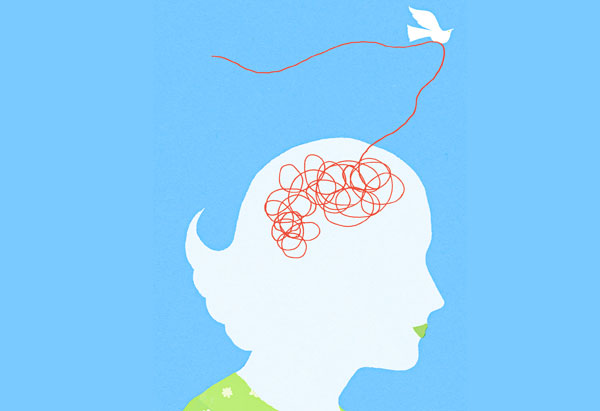The Amazing Brain: What Sets Humans Apart
One scientist is on a mission to discover what, exactly, separates our brains from those of animals.

Illustration by Christopher Silas Neal
Eminent neuroscientist V.S. Ramachandran is famous for studying rare neurological disorders that reveal the inner workings of the mind. In his new book, The Tell-Tale Brain, he goes one step further—using bizarre syndromes as a way to explore fundamental questions of what it means to be human. We asked him to explain.
O: One of the conditions you study is Capgras delusion, where a patient believes familiar people are impostors. What's happening there?
V.S. Ramachandran: The wiring that connects the visual and emotional centers is broken. So when a patient sees her mother, for example, she recalls the right memories, but they aren't linked to appropriate feelings. And the only way she can make sense of the situation is to say, That woman can't be my real mother.
O: So what do you learn from a patient like that?
VSR: Well, seeing what happens when one bit of wiring is cut can help us understand how the brain normally operates. Things like memory and emotion usually work together, but now we know there are two separate brain structures managing them.
O: What other disorders have led to discoveries?
VSR: There's one called alien hand syndrome, where a person's hand acts as if it has a mind of its own—grabbing objects, undoing buttons—due partly to damage in the anterior cingulate, an area involved in decision making. Even the thought, What do I want to do right now? originates there.
O: So free will is just a part of our anatomy?
VSR: A lot of philosophical subjects, like conscious choice and free will, can now be studied at the level of brain structures.
O: You speculate that an area called the angular gyrus might be at the root of human culture. Why?
VSR: We know that this area is several times bigger in humans than in apes. It's probably not coincidental that it appears to have expanded right around the time humans started creating art and language. Both are unique to our species.
O: Are those the only things that make humans unique?
VSR: There's also self-awareness—our mysterious ability to "see" ourselves through the eyes of others.
O: What lets us do that?
VSR: Mirror neurons, we think. That reflex when a baby smiles back at its mother? It's the product of mirror neurons. Now take that deeper: When you realize your smile can make someone else smile, you're using self-awareness.
O: You've called mirror neurons "Gandhi neurons" because they help create empathy. How so?
VSR: When you connect an action to an emotion—you see a person crying, and you can imagine her sadness—that's empathy. What's interesting is that patients with certain damage have hyperempathy. They feel another person's pain as if it were their own.
O: Is it possible Gandhi had a brain condition?
VSR: He may have been an enlightened individual whose neurological differences predisposed him to empathy.
This is Your Brain on O
O: One of the conditions you study is Capgras delusion, where a patient believes familiar people are impostors. What's happening there?
V.S. Ramachandran: The wiring that connects the visual and emotional centers is broken. So when a patient sees her mother, for example, she recalls the right memories, but they aren't linked to appropriate feelings. And the only way she can make sense of the situation is to say, That woman can't be my real mother.
O: So what do you learn from a patient like that?
VSR: Well, seeing what happens when one bit of wiring is cut can help us understand how the brain normally operates. Things like memory and emotion usually work together, but now we know there are two separate brain structures managing them.
O: What other disorders have led to discoveries?
VSR: There's one called alien hand syndrome, where a person's hand acts as if it has a mind of its own—grabbing objects, undoing buttons—due partly to damage in the anterior cingulate, an area involved in decision making. Even the thought, What do I want to do right now? originates there.
O: So free will is just a part of our anatomy?
VSR: A lot of philosophical subjects, like conscious choice and free will, can now be studied at the level of brain structures.
O: You speculate that an area called the angular gyrus might be at the root of human culture. Why?
VSR: We know that this area is several times bigger in humans than in apes. It's probably not coincidental that it appears to have expanded right around the time humans started creating art and language. Both are unique to our species.
O: Are those the only things that make humans unique?
VSR: There's also self-awareness—our mysterious ability to "see" ourselves through the eyes of others.
O: What lets us do that?
VSR: Mirror neurons, we think. That reflex when a baby smiles back at its mother? It's the product of mirror neurons. Now take that deeper: When you realize your smile can make someone else smile, you're using self-awareness.
O: You've called mirror neurons "Gandhi neurons" because they help create empathy. How so?
VSR: When you connect an action to an emotion—you see a person crying, and you can imagine her sadness—that's empathy. What's interesting is that patients with certain damage have hyperempathy. They feel another person's pain as if it were their own.
O: Is it possible Gandhi had a brain condition?
VSR: He may have been an enlightened individual whose neurological differences predisposed him to empathy.
This is Your Brain on O



